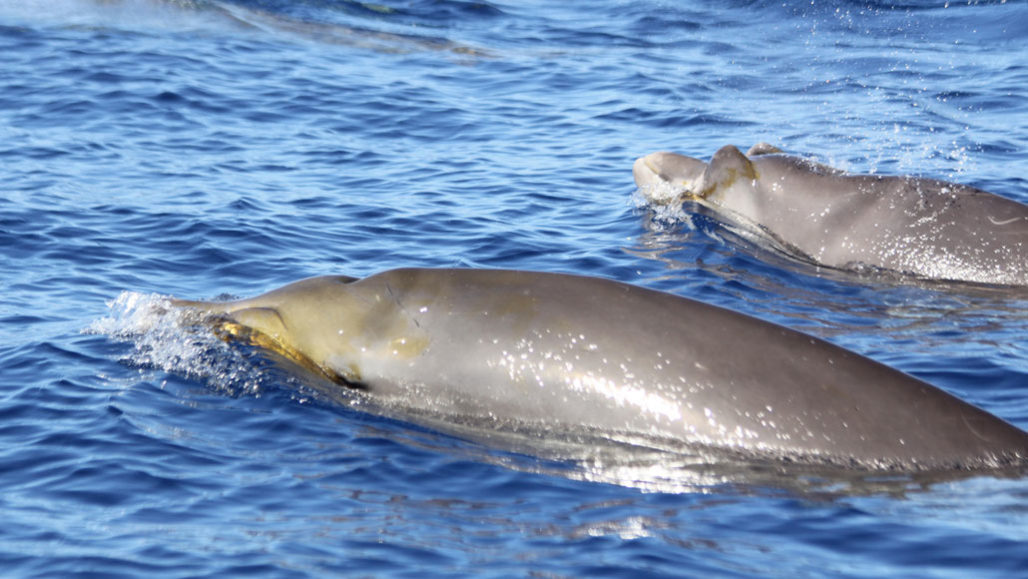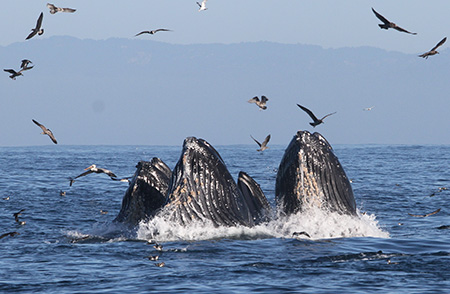Size of Juvenile Whales
Many species of whales and dolphins are known to be large. Orca are the largest type of dolphins, and male Orca can grow up to 8-meters long with a dorsal fin that is up to 2-meters tall. When you compare a baby or juvenile whale to an adult whale, it really puts into perspective how big some Cetaceans can be. Our cover image shows a juvenile Orca in between 2 adult females and you can see the size difference between them.
During the past few weeks, there were many of sightings of Transient Orca. On Family Day (February 17th), a pod of Transient Orca (T060s) were observed near Campbell River in the morning and over the course of the day, they travelled northward in Discovery Passage and entered Johnstone Strait. On average, the Orca were travelling approximately 6-km per hour which gives you an idea of how far they can travel in one day.
Humpback whales were observed near the north end of Calm Channel near Raza Island. A pair of Humpbacks (a mother and calf) were observed at the head of Toba Inlet during the last week of January. We have also received reports of Humpback whales that were observed north of the Victoria/Saanich area in Haro Strait during the past week. Pacific White-Sided dolphins are in many waterways but in small pods. Dall’s porpoises were observed in Loughborough Inlet and in Toba Inlet. Rounding our report are a few sightings of Harbour porpoises.
Boaters, please use caution on the water. Federal laws require boats to remain at least 400-m away when viewing Southern Resident Orca in critical habitats and for other types of Orca, laws require boats to remain at least 200-m away from them. For other species of whales, dolphins, and porpoises, boats must keep a minimum distance of 100-m away from them but the minimum distance changes to 200-m if there is a calf OR if the Cetaceans are resting. Remember N.E.W.S. when you see a whale, meaning put your boat in NEUTRAL, ENJOY the view, WAIT till the whales are at a fair distance, and then SLOWLY leave the scene.
WOWs works throught the year, so please continue to keep your eyes open, and report your sightings to us.
Review our current Volunteer Job Postings
Archive Explorer navigates 21,000+ Cetacean Sightings, images, videos and audio recordings.
*Recommended for desktop browsers and newer mobile devices
Archive Explorer dives into the Coastal Cetacean world. View Cetacean sighting locations, photos and videos:
- All species including Orca, Humpback, Grey Whale or Dalls Porpoise
- Follow the endangered Southern Residents Orca in the Salish Sea
- Search for encounters with T002C2 Tumbo
- Witness a close-up Orca encounter video in Port Alberni harbour
- Follow the T010s Transients as they hunt and travel the inside passage
- Track "KC", the ever popular Humpback's movements
- Locate any of 12,000 named locations on the BC and WA State coast
- Print custom sighting reports and maps (Coming Soon)
Archive Explorer Help Page explains many advanced functions
Send your Comments and Questions to: Archive Explorer Feedback
COMING SOON: Our New Archive Dataset Interface is in the works, but we don't want to hold up any ongoing research.
To access 21,000+ sightings in our database to November issue #2019-049 in a downloadable csv file for use in a spreadsheet, please Click Here.
“Between the early 1900s and the 1950s was the prime time for hunting these animals. But we were taking Bottlenose Whales off Nova Scotia up until the 60s,” says Laura Feyrer, a PhD candidate in marine biology at Dalhousie University.
By the height of the whaling industry, between 60,000 and 100,000 of the species had been caught by fishermen from Canada, Norway and Iceland.
“We believe from our research over the last 30 years that there’s between 100 and 200 animals left in the Nova Scotia population,” explains Feyrer….
read on
read on
The project began after the U.S. National Oceanic and Atmospheric Administration contacted the tech giant for help trying to find humpback whales in a very large volume of underwater recordings, explained Google software engineer Matt Harvey….
read on
A dramatic rescue effort by the National Sea Rescues Institute (NSRI), Bayworld and Port Elizabeth couple Stuart and Eva Laubscher ended when a decision was taken to euthanise the animal following several failed attempts to float it back out to sea.
The Laubschers stumbled upon the juvenile dwarf sperm whale on the beach ……
read on
Project Jonah general manager, Daren Grover, said four Arnoux’s beaked whales, first seen in Nelson harbour last Thursday, made their way out in to the wider Tasman Bay on Saturday….
read on
But elephant-sized beaked whales, named for their pointy snouts, have none of these advantages. These extreme divers swim in small groups, are too slow to outswim a killer whale, and rely on audible clicks to echolocate food deep in the ocean. Killer whales (Orcinus orca) should be able to hear them hunting below and easily pick them off as they ascend….
read on
read on








